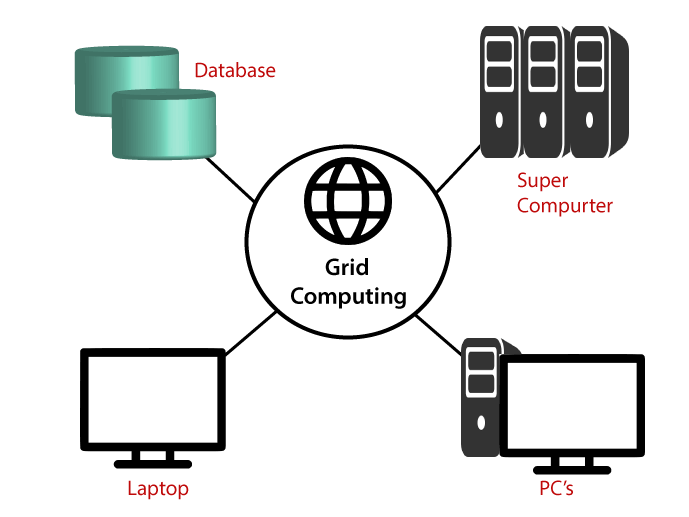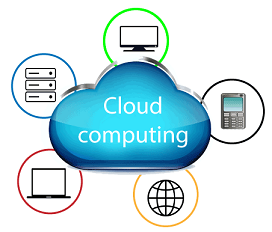Grid Computing vs Cloud Computing
What is Grid Computing?
Grid computing is a distributed structure of a large number of computers connected to solve a complicated problem. In grid computing, servers and computers run independently and are loosely connected by the Internet. Computers may connect directly or through scheduling systems.
In other words, Grid Computing involves a large number of computer which are connected parallel and makes a computer cluster.
Grid computing is used in various types of applications such as mathematical, scientific, and educational tasks via various computing resources.
Grid computing is a processor architecture that integrates computer resources from various domains to achieve a primary goal. The computers on the network will work together in grid computing on a project, thus acting as a supercomputer.
Grid systems are mainly designed for resource sharing by Distributed and cluster computing on a large scale. It divides the complex tasks into smaller pieces that are distributed to the CPUs and keeps in the grid.

What is Cloud Computing?
Cloud Computing is defined as the on-demand facility of computer power, database storage, applications, and other IT resources through the internet. It provides a solution for IT infrastructure at a low price.
In simple words, cloud computing means storing and accessing the data via the internet instead of the computer’s hard drive.
Cloud computing is a pay-per-use model.

Grid Computing Vs Cloud Computing
- Main objective: - The main objective of cloud computing is to offer the Service at a lower rate. It also offers scalability and flexibility so that the customer efficiently uses cloud computing with increased security and availability.
However, the grid computing objective is to focus on the network to solve complicated problems; it also provides a computer as a utility.
2. Types and Division: - The types of cloud computing are public clouds, private clouds, community clouds, and hybrid clouds.
However, Grid computing is a distributed computing system so its types are distributed information system and distributed pervasive systems.
- Use and Security: - A Large amount of data is stored in the cloud. So it offers security according to it. The data which is stored on the cloud is secured and only be access with the help of credentials.
Grid computing relates to idol energy in computers and is mainly used for something sensible.
- Basis of Dependency: - Cloud Computing is totally dependent on the internal. The cloud offers high security along with high performance.
Grid computing can do its work continuously, even if a computer stops or failure. The other computer will pick the working and make the system more efficient and reliable.
- Difference and Similarity: - cloud computing and grid computing are different from each other in some terms like architecture, business model, and interoperability.
The similarity between cloud computing and grid computing is both are network-based technologies
.6. Space and Storage: - In cloud computing, backup and restores the data is easy due to of its fast data processors. The updation in cloud computing are automatic and efficient.
However, in grid computing, space is saved, and access to additional resources can be done.
7.Remote Usage: - In cloud computing, management of computing resources are within a single location, which is located at a different place.
However, in grid computing, there is a distributed system where the resources are allocated at various locations, and can be located from various sites.
8. Resource Requirements: - Grid computing requires more resources, and cloud computing doesn’t access the resource directly; it gets resources via the internet.
9. Problem-Solving Techniques: - For job scheduling, grid computing uses all kinds of computing resources. In grid computing, the big task is split into multiple tasks, which is solved by various computers as the work assigns to a particular computer.
Cloud computing has resources that are pooling via grouping resources and needs a base from a cluster of servers.
10. Services and Capabilities: - Academic researchers mainly used Grid computing and have the ability to handle a large set of job that are complex and includes a large collection of data.
Cloud computing is totally internet-based computing. The cloud offers various types of services like management of data, job queries, the security of data, etc. It removes the cost of purchasing new hardware and software which are required to build applications.
11. Interoperability: - In grid computing, interoperability can be handled quickly, but cloud computing does not support interoperability.
Grid Computing Vs. Cloud Computing: Comparison Chart
| GRID COMPUTING | CLOUD COMPUTING |
| Grid computing is for Application-oriented. | Cloud computing is for Service-oriented. |
| In Grid computing, resources are shared among multiple computing units for processing a single task. | In cloud computing, all the resources are managed centrally and are place over different servers in clusters. |
| Grid computing is a collection of Interconnected computers and networks that can be called for large scale processing tools. | In cloud computing, more than one computer coordinates to resolve the problem together. |
| Grid computing is operated within a corporate network | Cloud computing can be accessed via the Internet. |
| In this, Grids are mainly owned and managed by an organization within its premises. | The cloud servers are owned by infrastructure providers and are placed in physically various locations. |
| It offers a shared pool of computing resources based on needs. | Cloud computing includes dealing with a common problem using a varying number of computing resources. |